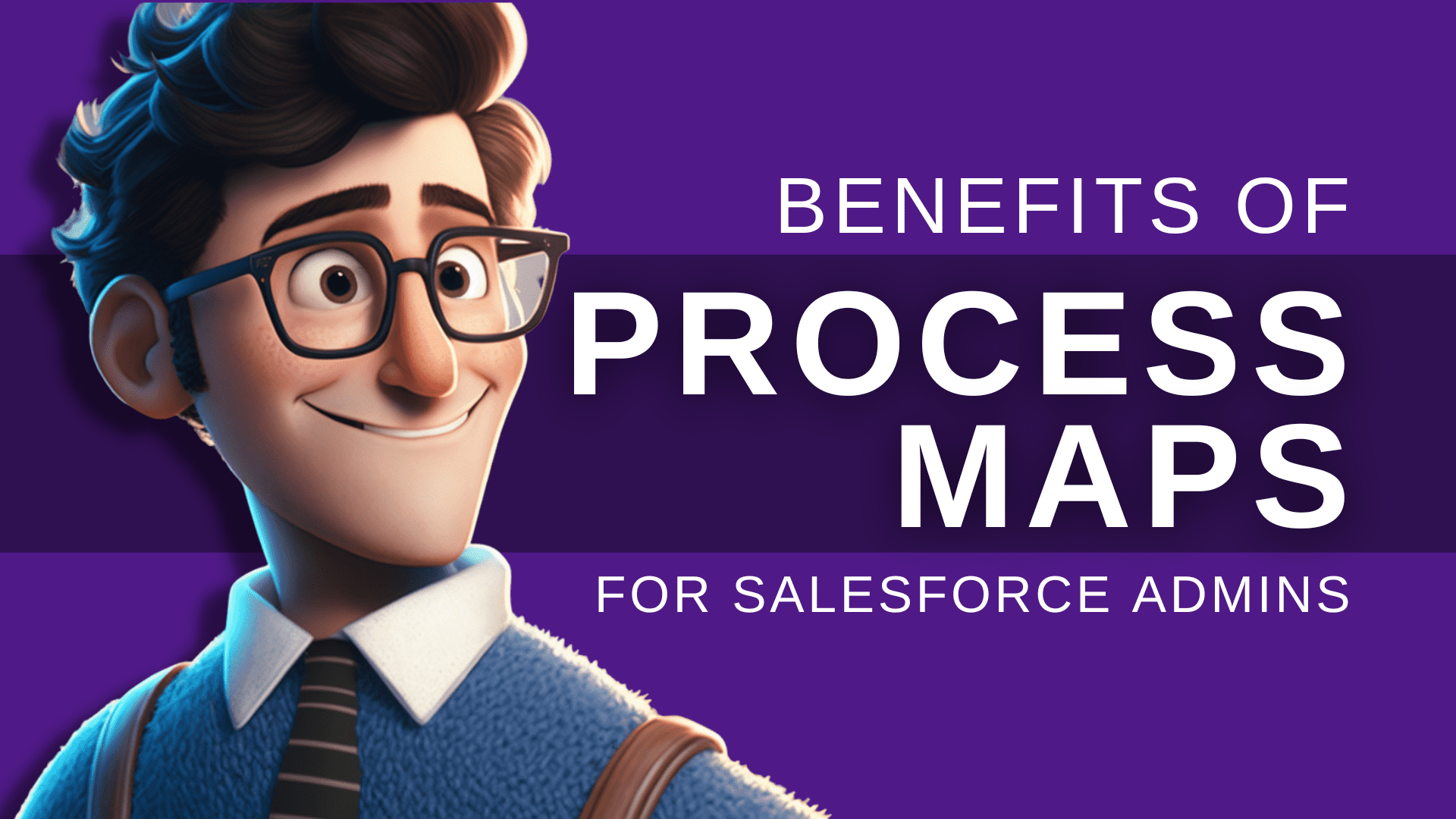10 Common Mistakes Salesforce Admins Make When Gathering Business Requirements

Are you a Salesforce Admin struggling to gather business requirements for your projects?
Don’t worry.
You’re not alone.
Many Salesforce Admins make common mistakes when gathering business requirements that can impact project success.
This article will explore the top 10 mistakes Salesforce Admins make when gathering business requirements and how to avoid them.
Introduction
Gathering business requirements is a crucial aspect of project management. It helps to ensure that project objectives are aligned with business needs. Salesforce Admins play a critical role in this process as they implement solutions within Salesforce. However, projects can quickly go off track without properly gathering business requirements, leading to delays and additional costs.
🔥 SUBSCRIBE! 🔥

Get practical Salesforce advice in your inbox!
Feeling overwhelmed by everything you have to do as a Salesforce Admin?
I know how it feels.
I created the FREE Brainiate Newsletter – to help you stay up-to-date with the latest Salesforce news, advice, and product recommendations.
Sign up for my newsletter and get all that information right in your inbox – without having to search for it yourself. You’ll be able to focus on your projects with peace of mind, knowing you’re always up-to-date on the latest Salesforce updates.
Click the button below and sign up for my FREE Brainiate Newsletter today!

Mistake #1: Lack of Communication With Stakeholders
When it comes to implementing a successful Salesforce solution, communication is critical. As a Salesforce Admin, it’s your responsibility to ensure that all stakeholders are involved in the requirement-gathering process and that everyone is clear on the project goals and deliverables.
Unfortunately, many Salesforce Admins fail to communicate effectively with stakeholders, leading to misunderstandings, delays in the project timeline, and even project failure. This can happen when Admins assume they know what their stakeholders want or fail to solicit feedback or involve stakeholders in decision-making processes.
To avoid this common mistake, take the time to establish open communication channels with stakeholders from the outset. This can be done in various ways, such as holding regular meetings, conducting surveys or interviews, or using collaboration tools like Salesforce Chatter, Slack, or Teams.
Additionally, use clear and concise language when communicating with stakeholders, avoiding technical jargon or industry-specific terminology that may not be familiar to everyone. This will help ensure everyone is on the same page and understands the project goals and requirements.
In summary, effective communication with stakeholders is a critical part of the requirement-gathering process and is essential to the success of any Salesforce project. By establishing open communication channels, involving stakeholders in decision-making, and using clear and concise language, Salesforce Admins can avoid failing to communicate effectively with stakeholders.
Here Are Some Ways That Salesforce Admins Can Avoid the Mistake of Lack of Communication With Stakeholders:
- Schedule meetings with stakeholders to discuss project goals, objectives, and requirements.
- Develop open communication channels with stakeholders to encourage feedback and collaboration.
- Create a communication plan that outlines the frequency, format, and purpose of communication with stakeholders.
- Assign a dedicated stakeholder liaison to act as a point of contact for stakeholders and maintain communication.
- Use visual aids such as diagrams, flowcharts, and wireframes to help stakeholders understand project requirements.
- Use plain language when communicating with stakeholders to minimize confusion and misunderstandings.
- Provide regular project updates to stakeholders to inform them of project progress and changes to requirements.
- Encourage stakeholder involvement in the project planning process to ensure that their needs are considered.
- Use project management tools to facilitate stakeholder communication, such as project management software or collaboration tools like Slack or Microsoft Teams.
- Finally, be open to feedback and willing to adjust project plans based on stakeholder input to ensure the project is aligned with their needs and objectives.
SNAG THESE FREE RESOURCES!

Struggling to Manage Your Salesforce Projects?
Master Project Management With Our Expert Resources for Salesforce Admins.
Check out some of these FREE RESOURCES, templates, ebooks, and courses to take your project management skills to the next level and take control of your Salesforce career!
Mistake #2: Unclear Objectives
As a Salesforce Admin, you know that gathering business requirements is a crucial part of your job. But did you know that one of the most common mistakes admins make is having unclear objectives? It’s easy to get caught up in the details of a project, but without a clear understanding of the end goal, you could waste time and resources on unnecessary features.
So, what can you do to avoid this mistake? The first step is to work closely with your stakeholders to identify the project’s goals and objectives. Ask questions like “What problem are we trying to solve?” and “What will success look like?” Once you clearly understand the objective, you can prioritize the features and requirements necessary to achieve it.
In addition to defining objectives, it’s essential to ensure they are communicated to everyone involved in the project. This includes stakeholders, developers, and anyone else impacted by the changes. By keeping everyone on the same page, you can ensure that the project stays on track and that there are no surprises along the way.
Remember, the key to success as a Salesforce Admin is never losing sight of the bigger picture. By keeping your objectives clear and communicating them effectively, you can ensure that your projects succeed and that you provide the best possible value to your organization.
Here Are Some Ways That Salesforce Admins Can Avoid the Mistake of Unclear Objectives:
- Collaborate with stakeholders to identify and define project objectives.
- Clearly define the project scope and goals.
- Use SMART (Specific, Measurable, Attainable, Relevant, Time-bound) objectives to ensure clarity and focus.
- Define success criteria and key performance indicators (KPIs) to measure progress toward objectives.
- Ensure all stakeholders agree on the objectives and know their roles and responsibilities.
- Continuously review and update objectives as the project progresses to ensure alignment with business goals and evolving requirements.
- Communicate objectives clearly and regularly to all stakeholders to ensure everyone is on the same page.
Mistake #3: Insufficient Planning
Insufficient planning is a common mistake that Salesforce Admins make when gathering business requirements. This often leads to delays, miscommunication, and even project failure. To avoid this mistake, Salesforce Admins must devote sufficient time and effort to planning.
One of the critical components of planning is developing a comprehensive project plan. This plan should clearly outline the steps involved in the requirements-gathering process, from the initial scoping phase to the final sign-off. It should also include timelines for each phase and roles and responsibilities for each team member involved in the project.
Another important aspect of planning is establishing communication channels. Salesforce Admins must ensure clear and open communication between all stakeholders involved in the project, including business users, developers, and project managers. This can be achieved by setting up regular meetings, providing progress reports, and using collaborative communication tools.
When planning the requirements-gathering process, it is also essential to be realistic about timelines and objectives. Rushing through the process or setting unrealistic goals can lead to errors, inaccuracies, and project failure. Therefore, Salesforce Admins must diligently plan, considering all possible variables and contingencies.
In summary, proper planning is critical for successful requirements gathering. By developing a comprehensive project plan, establishing clear communication channels, and setting realistic objectives, Salesforce Admins can avoid the mistake of insufficient planning and ensure the success of their projects.
Here Are Some Ways That Salesforce Admins Can Avoid the Mistake of Insufficient Planning:
- Develop a comprehensive project plan that outlines the steps involved in the requirements-gathering process.
- Define clear roles and responsibilities for each team member involved in the project.
- Set realistic timelines for each phase of the project.
- Establish communication channels with stakeholders to ensure everyone is on the same page.
- Identify potential roadblocks and develop contingency plans to address them.
- Ensure all team members have the necessary resources and tools to complete their tasks.
- Monitor project progress regularly and adjust the plan to stay on track.
- Ensure that project goals and objectives are clearly defined and aligned with business needs.
- Obtain buy-in from all stakeholders before moving forward with the project plan.
- Develop a risk management plan to identify and mitigate potential risks to the project.
Mistake #4: Lack of User Involvement
One of the biggest mistakes that Salesforce Admins make when gathering business requirements is not involving end-users. To develop a solution that meets end-users’ needs, it is essential to solicit feedback and involve them in the requirements-gathering process.
It is important to remember that end-users are the ones who will be using the solution daily. Hence, their input is critical in determining the functionality and design of the system. By involving end-users in the requirements-gathering process, you can better understand their needs and ensure the solution is tailored to their specific requirements.
In addition to the benefits of user involvement in the requirements-gathering process, several risks are associated with not involving end-users. For example, if the system is not designed with their needs in mind, they may be hesitant to adopt the new solution, leading to poor user adoption rates and reduced ROI.
To avoid this mistake, Salesforce Admins should prioritize user involvement in the requirements-gathering process. This can be achieved through various methods, such as conducting surveys or focus groups, soliciting feedback through user testing, or involving end-users in the project’s design phase.
By involving end-users in the requirements-gathering process, Salesforce Admins can ensure that the solution meets their needs and is designed with their input in mind. This approach can increase user adoption rates, improve ROI, and ultimately lead to a more successful project outcome.
Here Are Some Ways That Salesforce Admins Can Avoid a Lack of User Involvement:
- Identify key stakeholders and involve them in the requirements-gathering process.
- Conduct user interviews to gather insights into their needs and requirements.
- Conduct focus groups or workshops to gather feedback and insights from users.
- Develop user personas to understand user needs and requirements better.
- Incorporate user feedback throughout the project lifecycle.
- Develop user stories to ensure user needs and requirements are reflected in project deliverables.
- Conduct user acceptance testing to ensure the solution meets user needs and requirements.
- Encourage open communication channels between the Salesforce Admin and end-users to promptly address any issues or concerns.
- Develop user training materials to ensure that end-users understand how to use the solution effectively
- Consider involving end-users in the design process to ensure the solution meets their needs and preferences.
Mistake #5: Assuming Knowledge of Stakeholders
When gathering business requirements, making assumptions can be a massive mistake for Salesforce Admins. When you make assumptions about your stakeholders’ knowledge, you risk missing essential requirements and ultimately delaying your project.
To avoid this mistake, it’s essential to approach each stakeholder with a clear mind and a curious attitude. Even if you’re working with someone you’ve worked with before or who seems to know exactly what they want, it’s essential to ask questions and listen carefully to their answers.
Creating a stakeholder questionnaire is one way to ensure you’re not making assumptions. This questionnaire should focus on the stakeholder’s goals, objectives, and pain points. By asking these questions, you can better understand what they need from the project and how you can best support them.
Another way to avoid assumptions is to avoid using industry jargon or abbreviations that your stakeholders may not understand. Even if you think a term is a common knowledge, confirming that everyone is on the same page is essential.
Overall, assuming stakeholders’ knowledge is a common mistake that can be easily avoided. By asking questions and clarifying expectations, you can ensure that you’re meeting the needs of your stakeholders and delivering a successful project.
Here Are Some Ways That Salesforce Admins Can Avoid the Mistake of Assuming Knowledge of Stakeholders:
- Ask open-ended questions to encourage stakeholders to share their needs and expectations.
- Listen actively to stakeholders to ensure that you understand their requirements.
- Use plain language when discussing technical concepts to ensure stakeholders understand project decisions’ implications.
- Provide stakeholders with visual aids, such as diagrams and flowcharts, to help explain technical concepts and processes.
- Follow up with stakeholders after meetings to ensure everyone is on the same page regarding project requirements and goals.
- Conduct regular check-ins with stakeholders to ensure their requirements have not changed.
Mistake #6: Focusing Solely on Technology
As a Salesforce Admin, it’s easy to get lost in the technology and forget that the ultimate goal is to solve a business problem or achieve a specific objective. When focusing purely on the technology, you may overlook crucial factors such as the end-users’ needs, business processes, and workflows.
One common mistake Salesforce Admins make is assuming that if they build it, users will come. However, the reality is that if you build a solution that doesn’t align with business goals, users won’t adopt it, and the investment will be lost.
To avoid this mistake, it’s essential to collaborate closely with stakeholders to ensure that the solution aligns with the organization’s goals and objectives. Start by deeply understanding the business processes and workflows to identify pain points, inefficiencies, and opportunities. Use this information to design a solution that meets the end user’s needs and streamlines the business processes.
It’s also critical to communicate the solution’s benefits to the stakeholders and end-users to ensure buy-in and adoption. Remember that the success of a Salesforce project is not determined by the technology but rather by how well it solves the business problem or meets the organization’s objectives.
In conclusion, don’t make the mistake of solely focusing on technology and forgetting the bigger picture. Technology is a tool to solve a business problem or achieve an objective. By collaborating closely with stakeholders and aligning the solution with business goals and objectives, you can ensure the success of your Salesforce project.
Here Are Some Ways That Salesforce Admins Can Avoid the Mistake of Focusing Solely on Technology When Gathering Business Requirements:
- Work with stakeholders to understand their business needs and goals.
- Identify the business problem that the project is trying to solve.
- Determine the impact of the project on the business.
- Consider the business processes and workflows that the project will impact.
- Determine the key performance indicators (KPIs) to measure the project’s success.
- Identify any business risks or challenges that the project may encounter.
- Collaborate with stakeholders to develop a comprehensive project plan that aligns with business goals and objectives.
- Conduct regular check-ins with stakeholders to ensure the project is on track and aligned with business needs.
- Consider the end-user experience when developing solutions and workflows.
- Ensure that the project delivers value to the organization beyond just implementing technology.
Mistake #7: Inadequate Documentation
Salesforce Admins often fail to realize the importance of comprehensive documentation. Project requirements and objectives can quickly become cluttered and confusing without proper documentation. Salesforce Admins must develop a detailed and well-organized document that clearly states project goals, objectives, and requirements.
When gathering business requirements, it is essential to document the final product and the process leading up to it. This includes any discussions or negotiations with stakeholders, any changes made during the project, and any issues that arose and how they were addressed.
Having adequate documentation helps keep everyone on the same page and is a reference point throughout the project. It can also provide valuable insights and data for future projects.
To ensure that documentation is thorough and well-organized, it is vital to have a straightforward process in place for gathering and reviewing documentation. This includes assigning responsible parties for documentation, determining the appropriate format, and ensuring that documentation is regularly updated and maintained.
Inadequate documentation can lead to confusion, delays, and project failure. Salesforce Admins must prioritize documentation as a crucial component of successful project management.
Here Are Some Ways Salesforce Admins Can Avoid the Mistake of Inadequate Documentation:
- Develop a comprehensive documentation plan that outlines project goals, objectives, and requirements.
- Use a consistent and standardized format for all documentation to ensure it is easily understandable and accessible.
- Review documentation regularly to ensure that it remains up-to-date and accurate.
- Use diagrams and visual aids to make complex information easier to understand.
- Ensure that all stakeholders have access to documentation and understand its importance.
- Work with stakeholders to develop a feedback loop for documentation so that any changes or updates can be made promptly.
- Use tools like wikis, knowledge bases, or project management software to manage documentation.
- Clearly define roles and responsibilities for documentation so that everyone knows what they are responsible for and what is expected of them.
- Include documentation as part of the project plan, with precise deadlines and milestones for completion.
- Consider working with a technical writer or documentation specialist to ensure all documentation is clear, concise, and easily understandable.
Mistake #8: Lack of Testing
When a Salesforce Admin gathers business requirements and creates a solution, assuming everything will work ideally once implemented is not enough. That’s where testing comes in. Testing is a critical phase of any development process as it ensures that the solution meets the business requirements and doesn’t cause problems in other areas of the organization.
One common mistake that Salesforce Admins make is not prioritizing testing. Testing should be as necessary as any other phase of the project. A comprehensive testing plan that includes end-user testing and testing for system integration and performance should be developed to ensure everything works as intended.
End-user testing is crucial because it involves testing the solution from the users perspective who will use it daily. This type of testing can identify any usability issues or other problems that may not have been considered during the development process. Additionally, testing for system integration is essential because it ensures that the solution works seamlessly with other systems in the organization. Finally, performance testing ensures the solution can handle the expected workload without slowdowns or crashes.
In conclusion, testing is an essential aspect of any development process, and Salesforce Admins must develop a comprehensive testing plan to ensure that the solution meets the business requirements. By prioritizing testing from the outset, Salesforce Admins can ensure that the solution works as intended, enhances the user experience, and contributes to the organization’s overall success.
Here Are Some Ways Salesforce Admins Can Avoid the Mistake of Lack of Testing:
- Develop a comprehensive testing plan that includes end-user testing and testing for system integration and performance.
- Involve end-users in testing to ensure the solution meets their needs and expectations.
- Establish clear testing objectives and timelines to ensure that testing is completed on schedule.
- Consider the impact of changes to the system on existing business processes and workflows.
- Develop test scenarios covering all system aspects, including data migration and integration with other systems.
- Utilize testing tools and automation to streamline the testing process and improve accuracy.
- Conduct regular testing throughout the project lifecycle to identify issues early and minimize the impact on project timelines.
- Provide training and support to end-users to ensure they understand how to use the system effectively.
- Use testing results to inform decision-making and improve the quality of the solution.
- Document testing results and feedback to ensure all stakeholders are informed and can make informed decisions.
Mistake #9: Scope Creep
As a Salesforce Admin, it’s crucial to ensure that you always clearly understand the project scope. Failure to do so can lead to scope creep, where project requirements grow beyond the original scope. This can lead to missed deadlines, increased workload, and an unsuccessful project.
One of the main reasons that scope creep happens is a lack of communication with stakeholders. As you embark on a project, clearly defining the scope with all parties involved is crucial. This will help you avoid misunderstandings that might lead to additional requirements being added later.
Another critical factor in avoiding scope creep has a detailed project plan. This should include all requirements, milestones, and completion timelines. Once you have a plan, ensure all stakeholders know it and agree with the timeline and scope.
One final word of advice: be diligent when it comes to monitoring the scope of your project. Look for any changes or additions to the requirements, and address them as soon as possible. Doing so will help ensure that your project stays within its original scope and that you deliver the results that your stakeholders expect.
Here Is a Bulleted List of Ways That Salesforce Admins Can Avoid the Mistake of Scope Creep:
- Establish clear project goals and objectives from the outset.
- Develop a comprehensive project plan that outlines the project scope and requirements.
- Monitor project requirements throughout the project lifecycle.
- Prioritize project requirements with stakeholders.
- Avoid making changes to the project scope without first consulting stakeholders.
- Develop a change control process to manage any changes to the project scope.
- Regularly communicate project status updates to stakeholders.
- Ensure that project deliverables are tied to project goals and objectives.
- Review and evaluate project scope regularly to ensure it remains aligned with business needs and goals.
- Consider the potential impact of project scope changes on the timeline and budget.
Mistake #10: Failure to Prioritize Requirements
As a Salesforce Admin, feeling pressure to meet everyone’s needs and deliver what each stakeholder wants is natural. However, failing to prioritize requirements can lead to disaster. Not all requests are of equal importance or urgency; treating them as such can result in wasted time, effort, and other resources.
To avoid this mistake, it’s essential to set up a framework for prioritizing requirements based on their relevance to the organization’s goals and objectives. Work with stakeholders to establish a system that allows them to categorize their requests based on their importance, urgency, or impact on the organization’s overall performance.
Remember that some requirements may be more critical than others, such as those that align with your organization’s compliance needs or those that could create a significant impact on the bottom line. Therefore, gathering all relevant information on each requirement and evaluating them against the established priority framework is essential.
Failing to prioritize requirements can also lead to scope creep, where the project becomes too complex, involves more resources than expected, and extends beyond the original plan. Such a scenario could lead to delays and cost overruns and impact the reputation of your team and organization.
In summary, failure to prioritize requirements can be costly for Salesforce Admins. It is crucial to establish a framework for prioritizing requests and working closely with stakeholders to determine their relevance and urgency. This will help ensure that the most critical requirements are addressed first, saving time, effort, and resources and avoiding scope creep.
Here Are Some Ways That Salesforce Admins Can Avoid the Mistake of Failing to Prioritize Requirements:
- Work with stakeholders to determine the most critical requirements for the project’s success.
- Prioritize requirements based on their impact on the business and the project’s goals and objectives.
- Develop a comprehensive requirements matrix that lists all requirements and their priority levels.
- Assign priority levels to requirements based on their criticality and urgency.
- Use a scoring system to rank requirements based on their importance to the project’s success.
- Consider the feasibility of each requirement when prioritizing them.
- Consult with end-users to ensure their needs are considered in the prioritization process.
- Regularly review and update the requirements matrix to ensure that it remains up-to-date.
- Use agile methodologies to prioritize requirements in real-time based on changing project needs.
- Work with stakeholders to understand the project’s scope and prioritize requirements accordingly.
Conclusion
In conclusion, Salesforce Admins must be mindful of the common mistakes when gathering business requirements. One of the top mistakes is not effectively communicating with stakeholders, which can result in misunderstandings, wasted time, and frustration. It is critical to establish clear lines of communication and ensure that all parties are on the same page.
Another common mistake is not having clear project objectives. Salesforce Admins must clearly define project goals and ensure they are achievable and aligned with the organization’s objectives. Without clear objectives, projects can quickly derail, wasting resources and inefficiencies.
Proper planning is another essential factor in successful project outcomes. Salesforce Admins must establish a clear roadmap and timeline for each project, including key milestones and deadlines. This helps ensure that projects stay on track and are completed within the planned timeline.
By avoiding these common mistakes in gathering business requirements, Salesforce Admins can ensure that projects are aligned with business goals and objectives. With effective communication, clear project objectives, and proper planning, Salesforce Admins are better positioned to deliver successful projects that meet the organization’s needs.
FAQs
Q1: Can I involve stakeholders in the project planning process?
Absolutely! Involving stakeholders in planning ensures project goals and objectives align with business needs.
Q2: What is scope creep, and how can I avoid it?
Scope creep occurs when project requirements expand beyond the original scope. To avoid scope creep, Salesforce Admins must monitor project requirements and ensure they remain within the scope.
Q3: How do I prioritize requirements?
Prioritizing requirements involves working with stakeholders to determine which requirements are most critical to the project’s success. It’s essential to consider the business goals and objectives when prioritizing requirements.
Q4: Why is documentation necessary in the requirements-gathering process?
Documentation is essential in the requirements-gathering process because it helps ensure everyone is on the same page regarding project goals and requirements. Comprehensive documentation also helps to minimize misunderstandings and miscommunications throughout the project lifecycle.
Q5: Can I rely solely on technology to gather business requirements?
No, relying solely on technology to gather business requirements is a mistake. Salesforce Admins must work with stakeholders to ensure the solution aligns with business goals and objectives. Remember that technology is an essential tool, not the only consideration in project success.
By avoiding these common mistakes, Salesforce Admins can gather business requirements effectively and ensure that projects are aligned with business goals and objectives. Proper communication with stakeholders, clear project objectives, and comprehensive planning are essential for success. Remember to prioritize requirements, involve end-users, and document everything. Doing so can ensure that your Salesforce projects are successful and deliver value to your organization.






